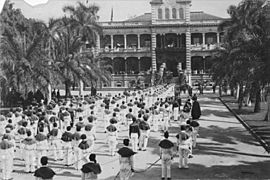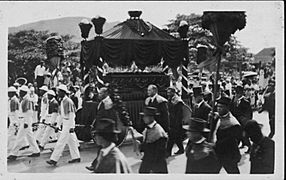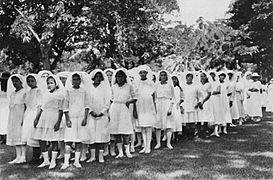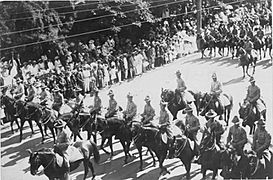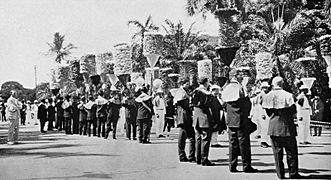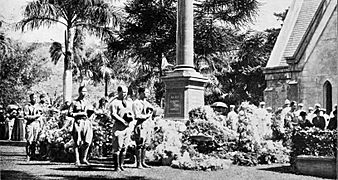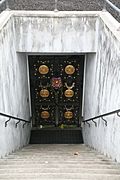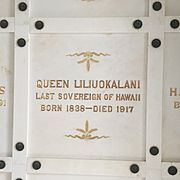Death and state funeral of Liliʻuokalani facts for kids
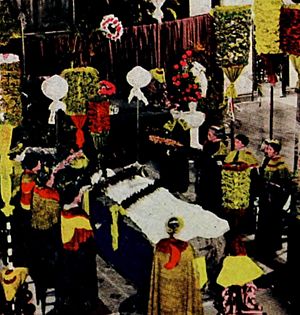
Queen Liliʻuokalani, the last monarch of Hawaii, died on November 11, 1917. Her royal flag was raised over her home, Washington Place, to let everyone know she had passed. Her body was moved at midnight under military guard for embalming. After a traditional Hawaiian mourning period with chanting and wailing, people could view her body, which was covered by a silk shroud. Her state funeral was held in the throne room of ʻIolani Palace on November 18, 1917. A large procession followed, leading to the Royal Mausoleum of Mauna ʻAla. About 1,500 adults and children were part of this procession.
Her Passing
Queen Liliʻuokalani died at her home, Washington Place, at 8:30 a.m. on November 11, 1917. She was seventy-nine years old. Her lady-in-waiting, Lahilahi Webb, said the Queen's health had been failing quickly in the weeks before her death. Her doctor, William Cotton Hobdy, Prince Jonah Kūhiō Kalanianaʻole, and his wife Elizabeth Kahanu Kalanianaʻole were with her at the end. Her private secretary, Curtis P. Iaukea, immediately raised her royal flag over Washington Place. This was the signal that she had died.
Immediately following a doctor's statement that life was gone, Rev. Leopold Kroll of the Hawaiian congregation of St. Andrew's Cathedral and Rev. Henry H. Parker, pastor of Kawaihao church were notified, and the bells began their sad tolling - 79 times they tolled, telling all Honolulu that Queen Lilliuolakani, 79 years old, was dead.
—Honolulu Star-Bulletin
The bells of Honolulu rang 79 times, once for each year of her life, to announce her passing to the city.
State Funeral and Traditions
A state funeral is a public funeral ceremony. It is held to honor people of national importance. Curtis P. Iaukea was in charge of the funeral plans. However, the governor of the territory, Lucius E. Pinkham, decided to give her a state funeral. He then took charge of the arrangements.
Hawaiian tradition says that the birth or death of an aliʻi (a Hawaiian chief or royal) is announced by nature. Months before Liliʻuokalani's death, schools of red āweoweo fish were seen off the coast of Oahu. These fish are traditionally linked to the death of a Hawaiian royal.
After the royal flag was raised, many people came to Washington Place to show their respect. The Hawaiian National Guard stood guard at the gates. Hawaiian tradition also said that a royal body could only be moved after dark. So, at midnight on Monday, Liliʻuokalani's body was moved. It was carried under military guard along torch-lit streets to Kawaiahaʻo Church for embalming.
On Tuesday, her body lay in state for 12 hours. It was not in a casket. Instead, it was covered only by a silk shroud. This was for the traditional Hawaiian mourning, which included chanting and wailing. After this, her body was placed in a casket for viewing until Saturday evening. Her state funeral was held in the throne room of ʻIolani Palace on November 18, 1917.
Her casket was then moved from the palace to the Royal Mausoleum of Mauna ʻAla. This was where her family members were buried. Long ropes, 1200 feet long, were pulled by 204 workers to move the casket. During this procession, composer Charles E. King led a youth choir in singing "Aloha ʻOe". The song was then sung by everyone in the procession and the crowds watching.
Films were made of the funeral procession. These films were later stored at ʻĀinahau, the former home of her sister. Sadly, a fire on August 1, 1921, destroyed the home and everything in it, including the funeral films.
For a week, the casket was placed in the Kalākaua Crypt underground. Her lady-in-waiting, Lahilahi Webb, and others stood vigil over her remains. On November 26, after another ceremony, the casket was sealed in a special spot next to her husband, John Owen Dominis.
The state funeral cost the government about $8,500.
The Grand Procession
Thousands of adults and children marched in Queen Liliʻuokalani's funeral procession. The order of the procession showed the many groups who came to honor her.
The procession included:
- Police officers on foot and on horseback.
- The Royal Hawaiian Band led by Captain Henri Berger.
- Cadets from Kamehameha School and St. Louis College.
- Boy Scouts.
- Many Hawaiian Societies, with over 1,500 members. These included groups like the Ahahui Kaahumanu, whose members wore black dresses and yellow feathered leis.
- Girls from St. Andrew's Priory School.
- Various U.S. military groups, including the U.S. Infantry, Cavalry, Field Artillery, Marines, and Navy.
- Sailors from the Japanese cruiser Tokiwa.
- The Queen's doctor and her personal helpers.
- Choir boys from St. Andrews Cathedral and other clergy.
- Important officials like the Governor and members of the U.S. Congress.
- The "Poolas," who were 204 stevedores (dock workers) who pulled the Queen's casket.
- Bearers of Hawaiian and Japanese decorations.
- The casket itself, with traditional Hawaiian Kāhili (feather standards) and pallbearers.
- Prince Kalanianaʻole and Princess Kalanianaʻole.
- Other government officials, judges, and members of the Hawaiian Senate and House of Representatives.
- Students from other schools like Punahou and Honolulu Military Academy.
Images for kids


